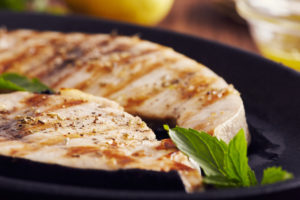
#28: Swordfish
The well-named swordfish has been returning to menus and fish markets in recent years, after a brush with overfishing a decade ago. Management of the stocks in the Atlantic has made swordfish populations tenable again. If the program keeps up, the average swordfish--much smaller than it once was, will get bigger, too. The recreational fishing industry is a friend in this case, because swordfish are prized catches. A wall-mounted swordfish in the man-cave is a familiar cliche.

Swordfish can grow to be over a thousand pounds. More common are 100-to-300-pound specimens. A fish that big is not filleted, but steaked. A piece of swordfish resembles that of tuna in every way but color; the swordfish has a silvery bronze look. It contains less fat than tuna, but for some reason it doesn't get tough unless you really overcook it. That's where things get tricky. Swordfish requires more cooking than tuna does, so you have to work both ends of the thermometer. But a if steak-like fish that needs full cooking appeals to you, sword is the fish for you.
While all kinds of restaurants serve swordfish, I've always found Italian chefs do the best work with the species. ("Pesce spada" is the Italian name for the fish.) Particularly when grilled and served with the light, herbal sauces made from olive oil, garlic, crushed red pepper and herbs, swordfish shows off its unique flavors best.
Drawbacks To Swordfish
If there's a problem with eating swordfish, it's in its higher-than-average mercury content. That's a result of its being at the top of the ocean food chain. But it's no worse in that regard than tuna. Just don't eat it all the time.
 Swordfish can grow to be over a thousand pounds. More common are 100-to-300-pound specimens. A fish that big is not filleted, but steaked. A piece of swordfish resembles that of tuna in every way but color; the swordfish has a silvery bronze look. It contains less fat than tuna, but for some reason it doesn't get tough unless you really overcook it. That's where things get tricky. Swordfish requires more cooking than tuna does, so you have to work both ends of the thermometer. But a if steak-like fish that needs full cooking appeals to you, sword is the fish for you.
While all kinds of restaurants serve swordfish, I've always found Italian chefs do the best work with the species. ("Pesce spada" is the Italian name for the fish.) Particularly when grilled and served with the light, herbal sauces made from olive oil, garlic, crushed red pepper and herbs, swordfish shows off its unique flavors best.
Drawbacks To Swordfish
If there's a problem with eating swordfish, it's in its higher-than-average mercury content. That's a result of its being at the top of the ocean food chain. But it's no worse in that regard than tuna. Just don't eat it all the time.
Swordfish can grow to be over a thousand pounds. More common are 100-to-300-pound specimens. A fish that big is not filleted, but steaked. A piece of swordfish resembles that of tuna in every way but color; the swordfish has a silvery bronze look. It contains less fat than tuna, but for some reason it doesn't get tough unless you really overcook it. That's where things get tricky. Swordfish requires more cooking than tuna does, so you have to work both ends of the thermometer. But a if steak-like fish that needs full cooking appeals to you, sword is the fish for you.
While all kinds of restaurants serve swordfish, I've always found Italian chefs do the best work with the species. ("Pesce spada" is the Italian name for the fish.) Particularly when grilled and served with the light, herbal sauces made from olive oil, garlic, crushed red pepper and herbs, swordfish shows off its unique flavors best.
Drawbacks To Swordfish
If there's a problem with eating swordfish, it's in its higher-than-average mercury content. That's a result of its being at the top of the ocean food chain. But it's no worse in that regard than tuna. Just don't eat it all the time.
